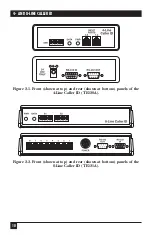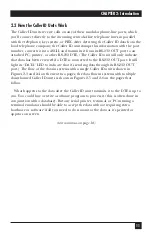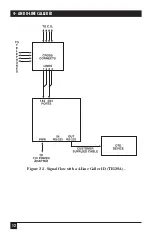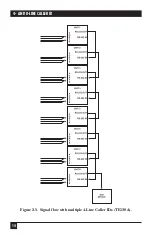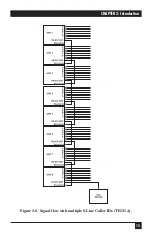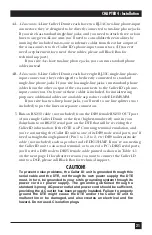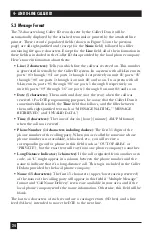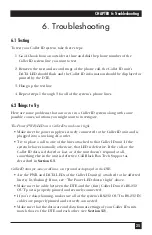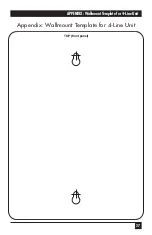
23
CHAPTER 5: Operation
5. Operation
NOTE
We recommend that the first time you start up your Caller ID system,
you test it as described in
Section 6.1
.
5.1 LEDs
There are two LEDs on the front panel of each Caller ID unit. One is the Power
LED, which lights as soon as the unit starts receiving power. The other is the DATA
LED, which flashes to show that data is being sent from the Caller ID unit to the
DTE. (A unit won’t light its DATA LED unless it’s connected to a powered DTE—
specifically, it needs to receive Pin 7, RTS, active/high on its RS-232 OUT port.)
5.2 How the Unit Handles Caller ID Information
The Caller ID unit receives standard Caller ID information from the telephone
company’s central office as Bell
®
202A modem tones, between the first and second
rings of the phone call. The Caller ID unit takes this information, formats it as an
ASCII text record (as shown in Figure 5-1), prefaces it with the number of the port
on which the call was received, and sends it from its RS-232 OUT port to the DTE.
NOTE
If handshaking between the Caller ID system and the DTE is prolonged,
data could be lost.
Figure 5-1. Sample Caller ID records produced by the Caller ID unit
(not actual width—filler spaces compressed).
LINE DATE TIME PHONE NUMBER L NAME*
08 3/24 9:15 AM OUT OF AREA
01 3/24 9:16 AM 1-724-555-3407 Jane Doe
12 3/24 10:03 AM 1-205-555-4000 L John Smith
03 3/24 10:03 AM PRIVATE
10 3/24 10:06 AM 555-9818 Bednarski Motor
03 3/24 8:00 PM 555-2549 Sam Jones
*Labels are shown here at the tops of the columns for clarity only.
No such labels are sent to the DTE.
Summary of Contents for TE120A
Page 13: ...12 4 AND 8 LINE CALLER ID Figure 2 3 Signal flow with a 4 Line Caller ID TE120A ...
Page 14: ...13 CHAPTER 2 Introduction Figure 2 4 Signal flow with an 8 Line Caller ID TE121A ...
Page 15: ...14 4 AND 8 LINE CALLER ID Figure 2 5 Signal flow with multiple 4 Line Caller IDs TE120A ...
Page 16: ...15 CHAPTER 2 Introduction Figure 2 6 Signal flow with multiple 8 Line Caller IDs TE121A ...
Page 29: ...NOTES ...


